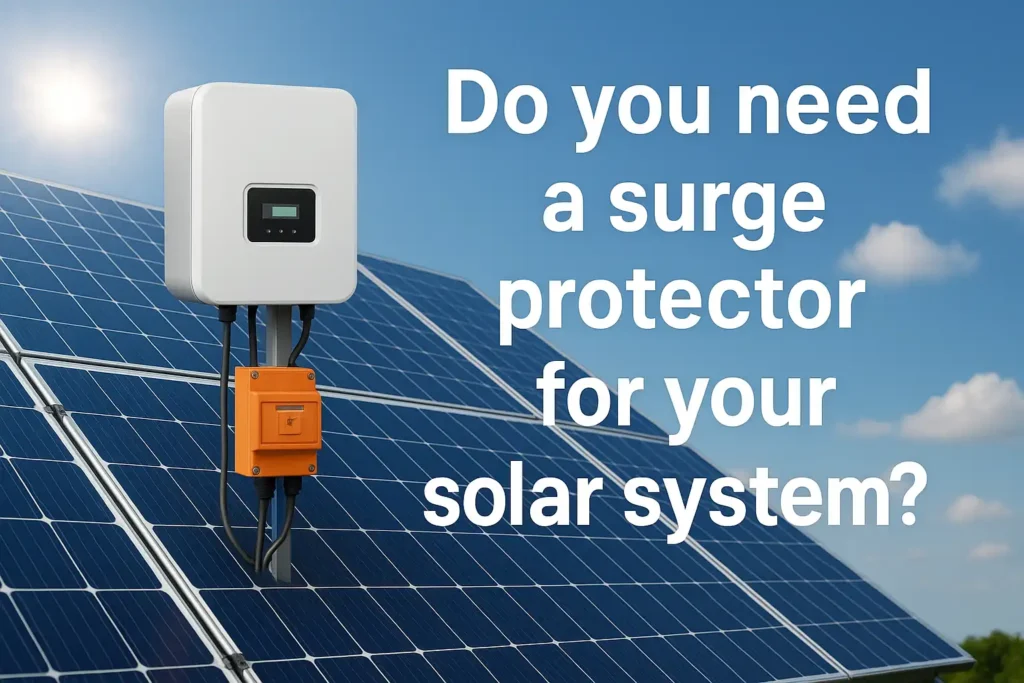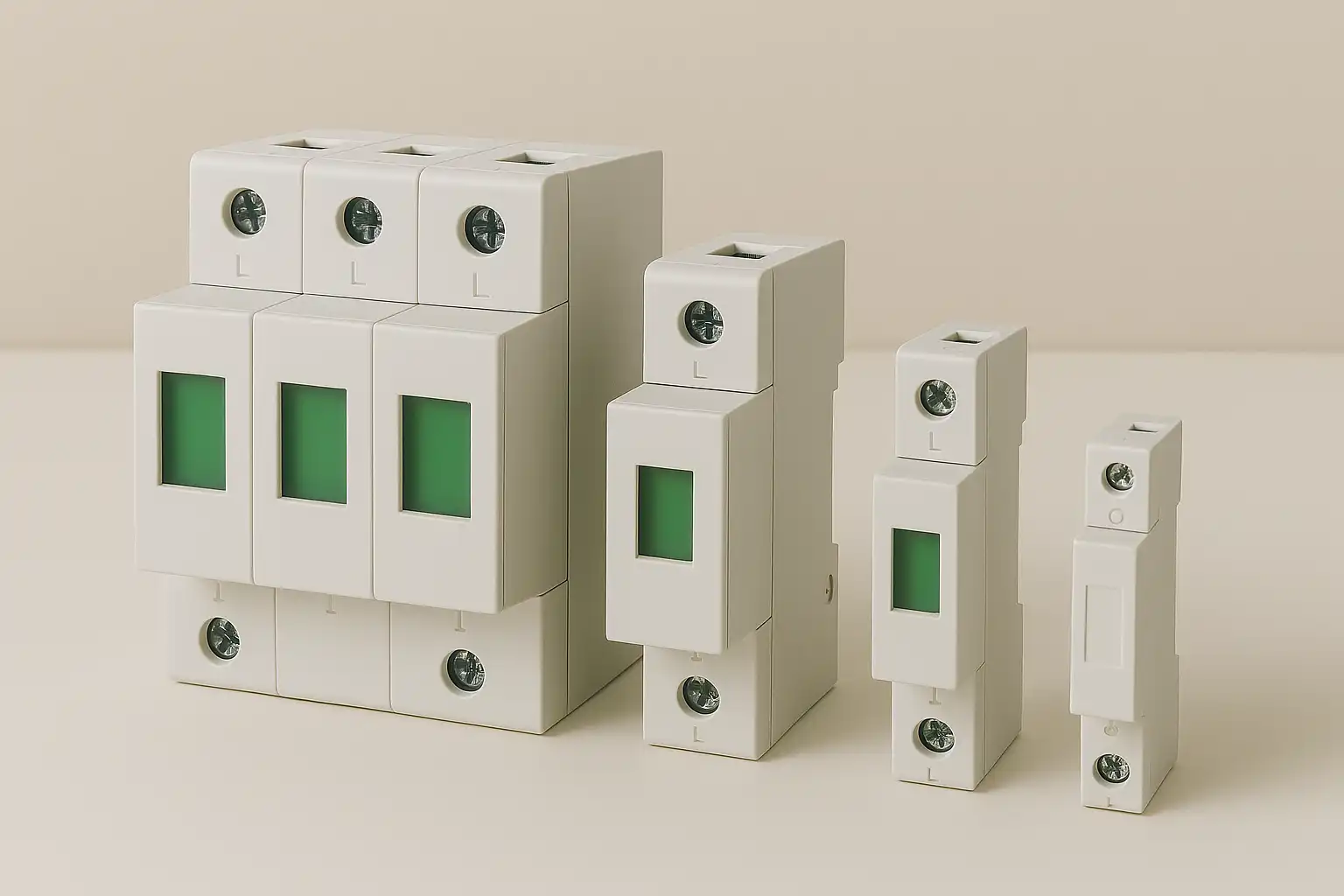Most solar systems should have a surge protector for safety. It gives you peace of mind. This device protects your home from power spikes. Power spikes can happen at any time. Lightning or quick voltage changes can hurt your solar equipment. A surge protector keeps your system safe. It helps your solar system last longer. It also protects your investment.
Key Takeaways
- Surge protectors keep your solar system safe from power spikes. These spikes can happen because of lightning or voltage changes. Surge protectors help your equipment last longer.
- The AC and DC sides of your solar system both need surge protection. This helps protect important parts like inverters and controllers.
- Surge protectors stop expensive repairs. They also lower downtime and make your home and solar system safer.
- Pick surge protectors with the right ratings and certifications. Put them in important places and make sure they are grounded well for the best results.
- Check your surge protector often for any damage. Replace it if needed to keep your solar system safe and working well.
Why Use a Surge Protector
Power Surge Risks
Power surges can happen at any time. Lightning, power grid issues, or turning big appliances on and off can cause sudden voltage spikes. These spikes move through your wires and reach your solar equipment. Sensitive parts like inverters and controllers can get hurt. You might not see damage right away. But if surges keep happening, your solar system will not last as long.
A surge protector works like a shield. It stops or moves extra voltage away from your important equipment. This small device helps you avoid expensive repairs. It keeps your solar system working well. You protect your solar panels and your home’s other devices.
Tip: Even a small surge can hurt your system. Using a surge protector helps you feel safe during storms or blackouts.
Solar System Vulnerabilities
Solar panels are strong and can handle most weather. But the parts that link your panels to your house, like inverters and charge controllers, are more delicate. These parts face many risks:
- Solar inverters can break if the voltage or frequency is wrong. This can cause damage like a short circuit.
- Too much voltage from the inverter can hurt other equipment. You cannot easily stop this without extra protection.
- Sometimes, controllers for more than one solar system send too much voltage to your devices.
- Surge protective devices (SPDs) help with lightning, but they might not stop smaller surges from inverters.
- Utility workers treat the system as live because inverters can keep sending power, which is risky.
If the inverter output has too much ripple or distortion, it can stress other parts of your system. Tests show that using a filter can help with these problems. For example, a filter can lower total harmonic distortion from 32% to just 0.43%. This big drop means your equipment gets fewer voltage spikes and less stress.
You need surge protection on both the AC and DC sides of your solar system. The AC side connects to your house and the grid. The DC side connects to your panels. Both sides can get surges, so you should protect each one.
Note: A surge protector is a small cost that can save you from big repair bills and keep your solar system safe for a long time.
What Can Go Wrong
Equipment Damage
A power surge can really hurt your solar system. Inverters and charge controllers are very sensitive. A big surge can burn these parts in seconds. Even small surges can slowly make your equipment weaker. You might not see the damage right away. Your system may not work as well or last as long.
Surge protection devices (SPDs) help stop these problems. They work like a shield and block extra voltage. This keeps your important equipment safe. If you do not use SPDs, you could lose expensive parts. You might also wait a long time for repairs. Many people with solar systems have learned this the hard way.
Tip: Solar and wind systems can get damaged by surges. Using SPDs helps stop early failures and keeps your system working well.
Safety and Cost Impacts
Surges can do more than break equipment. They can also cause safety problems. A broken inverter or controller can get too hot or even catch fire. This can put your home and family in danger. Insurance companies might not pay for damage if you do not use the right protection.
Skipping surge protection can cost you more money. Repairs and new parts can get expensive fast. If your system stops working, you lose money because it does not make power. You might also need more maintenance visits, which cost more.
Here is a table that shows how surge protectors help keep solar systems safe and save money:
| Statistic Description | Value/Detail |
|---|---|
| Total surge protectors installed in solar PV applications | Over 4.6 million globally |
| Countries leading surge protector mandates | Germany, U.S., India |
| Percentage of new solar power systems with surge protection | More than 60% |
| Benefits of surge protection devices (SPDs) | Avoid equipment damage, reduce downtime, lower maintenance costs, improve safety |
| Smart SPD integration | 14.8 million SPDs with IoT-enabled diagnostics deployed globally |
| Number of commercial buildings with smart SPDs | Over 160,000 |
- Surge protectors help you avoid expensive repairs.
- They keep your system running and stop downtime.
- SPDs make your system safer and can help with insurance.
- You can use your solar system for more years.
Using surge protectors keeps your equipment safe. It also saves you money and helps you worry less.
Surge Protector Types
AC and DC Protection
You need to know that solar systems use both AC (alternating current) and DC (direct current) power. Your solar panels make DC power. Your inverter changes this DC power into AC power for your home. Surges can enter your system on either side. That is why you need surge protectors for both AC and DC lines.
- AC surge protectors guard your home’s wiring and appliances from voltage spikes coming from the grid or inverter.
- DC surge protectors protect your solar panels and the wires that connect them to the inverter.
Some surge protectors are called Type 1 SPDs. You install these at the main service entrance. They stop big surges, like those from lightning. Other types, like Type 2 SPDs, go inside your system to catch smaller surges. When you choose a surge protector, look for the UL 1449 certification. This standard tests devices for safety and performance. It checks things like Voltage Protection Rating (VPR) and Nominal Discharge Current. These numbers show how well the device can handle real surges in solar systems.
Tip: Brands like MidNite Solar make surge protectors for both AC and DC sides. You can find models that fit your system’s needs.
Outdoor and Weather Ratings
Solar systems often sit outside. Your surge protector must handle rain, dust, and sun. Look for outdoor-rated devices. For example, a NEMA 4X rating means the device can stand up to harsh weather. This keeps your protection working, even in storms or heat.
| Rating | What It Means | Good For |
|---|---|---|
| NEMA 1 | Indoor use only | Inside panels |
| NEMA 3R | Outdoor, rain-resistant | Covered outdoors |
| NEMA 4X | Outdoor, dust and water tight | Harsh environments |
You should always check the label before you buy. A good outdoor surge protector will last longer and keep your solar system safe.
Choosing and Installing
Key Factors
When you pick a surge protector, check a few things. Your system size and voltage are important. Where you live matters too. If your area has lots of storms, you need stronger protection. Always look at how well the device works before buying. Here is a table to help you know what to check:
| Metric | Description |
|---|---|
| Surge Current Rating | The highest current the device can handle during a surge (20kA, 40kA, etc.) |
| Response Time | How fast the device reacts to a surge (less than 25 nanoseconds is best) |
| Voltage Rating (Uc) | The top voltage the device can handle safely |
| Short-Circuit Current Rating (SCCR) | Shows if the device can survive a fault without damage |
| Environmental Durability | Ratings like IP65 mean it can handle dust and water outside |
Make sure your surge protector meets safety rules. Look for labels like UL 1449, IEC 61643, or CE marking. These labels mean the device passed safety tests. Following these rules keeps your system safe and working well.
Installation Tips
You need to put protection where surges might get in. This means at service panels, load centers, and near your inverter. Good grounding is very important. Using layers of protection works best. Use breakers, fuses, and surge protectors together.
Here are some tips to keep your system safe:
- Test insulation resistance to find faults.
- Do surge tests to check if your device works.
- Check your surge protector often for cracks or burns.
- Replace your device when the maker says to.
- Check more often if you live where it is dusty or wet.
Tip: If you are not sure how to install these, ask a professional. They know how to set up your system safely.
Picking the right surge protector and installing it well helps your solar system last longer and work better.
Using a surge protector keeps your solar system and money safe. More countries are using renewable energy now, so protection is important.
- Solar farms are growing fast, so they need to stay safe from storms and power problems.
- The European Union wants 32% of its energy to be renewable by 2030, so more solar panels need safety tools.
- New surge protection, like Raycap’s ProTec PV Box 7y, helps your system work well and stay safe.
Start protecting your solar system today. If you do not know how to install it, ask an expert for help.
FAQ
Do you need a surge protector for both AC and DC sides of your solar system?
Yes, you do. Surges can enter from the grid or from lightning. You protect your inverter and panels by using surge protectors on both AC and DC sides.
How often should you check or replace your surge protector?
You should check your surge protector every year. Look for signs of damage, like cracks or burns. Replace it if the manufacturer recommends or if you see any problems.
Can you install a surge protector yourself?
You can install some surge protectors if you have electrical experience. If you feel unsure, hire a licensed electrician. Safety always comes first.
Will a surge protector affect your solar system’s performance?
No, a surge protector will not slow down or change your system’s output. It only works when a surge happens. The rest of the time, it stays passive and does not affect your power.
The following information may be of interest to you
How to Replace a Surge Protector Safely and Efficiently
What You Need to Know About Surge Protection Device Lifespan
Is the location of installing surge protectors important?
How to Test Surge Protection Devices for Optimal Performance




